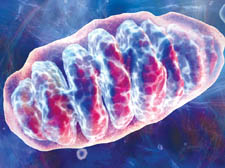|
|
 |
| |
 An image showing the three-dimensional structure of mitochondria An image showing the three-dimensional structure of mitochondria
|
Poor sell: organism that’s to die for
A book about our cellular make-up argues we need to pay more attention to the ‘suicidal’ energy-giving mitochondria, writes Professor Lewis Wolpert
Power, Sex, Suicide: Mitochondria and the Meaning of Life.
By Nick Lane. Oxford University Press £9.99. Order this book
MITOCHONDRIA are small components in our cells and there may be hundreds in each cell. Their function is to provide the energy which cells use to keep us alive, and allow us to do all the things we do.
Nick Lane loves mitochondria and has in his book, Power, Sex, Suicide: Mitochondria and the Meaning of Life, made an excellent case for them to have more attention than they have received from biologists.
Lane claims that a major part of our lives have resulted from the evolution of mitochondria in the cells that make up our bodies, and that they also provide an explanation for sex and ageing.
For someone with no biological knowledge, this is not a simple book as it is rather technical and not always easy to understand. For example, mitochondria are bounded by a double membrane, and make a key energy-rich molecule called ATP, the energy currency of cells.
ATP is generated by protons that result from chemical reactions of our food with oxygen. These protons are pumped across the inner membrane, and when they return ATP is synthesised.
Even so, the book is full of interesting ideas and explanations relating to the function of cells, and their evolution. There are also important accounts of how the related science progressed, including where the scientists went wrong.
Lane himself is critical of some current ideas and puts forward his own views.
Our cells and the cells of all animals are termed eukaryotes as they have a nucleus which contains the genes, mitochondria, and a flexible, almost fluid external membrane.
Bacteria, by contrast, are very much smaller, and have neither a nucleus nor mitochondria, and have an external, rather rigid cell wall.
How our ancestral bacterium billions of years ago gave rise to a eukaryotic cell is a central problem. It is generally accepted that somehow some primitive cell engulfed a bacterium which then became a mitochondrion.
The rigid cell wall of bacteria prevents water entering by osmosis and bursting it. Eukaryotic cells have solved this problem by pumping out sodium. This is a point neglected by Lane but may have important implications for evolution of the eukaryotic cell.
Without the evolution of the eukaryotic cell with its mitochondria, we would not be here today, as Lane emphasises.
Mitochondria reproduce by dividing into two. A few of the genes’ coding for their proteins are in the mitochondrion itself, while most of the genes, several hundred, are in the nucleus of the cell. Thus the reproduction of mitochondria requires co-operation between the nuclear and mitochondrion genes.
For this reason Lane argues, the mitochondria in a cell must have only one origin order to avoid confusion, and that this is the reason that the mitochondria in the egg gives rise to all the mitochondria in the body, and the sperm contributes none.
He then argues that this is also the why there are two sexes – but I cannot follow his reasoning.
Animals having two sexes is a key mechanism for eliminating bad genes from males, and for getting new gene combinations, but is not related to mitochondria.
Nevertheless, because mitochondria are only inherited through the female line, and sperm add none, they can be used to trace genetic inheritance. Thus a Mitochondria Eve who lived in Africa some 170,000 years ago is thought to be the mother of all mothers.
Mitochondria are also key players in the suicide programme which all our cells have. When things go wrong in a cell, particularly if they may become cancerous, this suicide programme is often turned on and the cells die.
In embryonic development, this programme is quite widely used. For example your fingers are separated by the death of the cells between them. Mitochondria provide a key internal signal for this mode of death.
Finally, there is ageing, for which Lane lays much blame on mitochondria.
The key lies with oxygen and free radicals. Oxygen is required in cells to produce energy from the molecules derived from food. Free radicals, which are highly reactive molecules, are a natural product of this process.
Free radicals can damage the mitochondria and this leads to less energy production, which is a characteristic of ageing. But as we oldies know, there is more to ageing than just low energy wear and tear and problems from memory to knees are involved. There are, in fact, other theories of ageing.
Mitochondria are our friends and really matter. But they are only a component of cells, who are our true masters.
|
| |
|
 |
|
| |
 |
|
 |
|
 An image showing the three-dimensional structure of mitochondria
An image showing the three-dimensional structure of mitochondria

